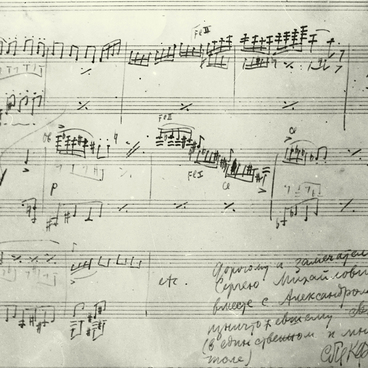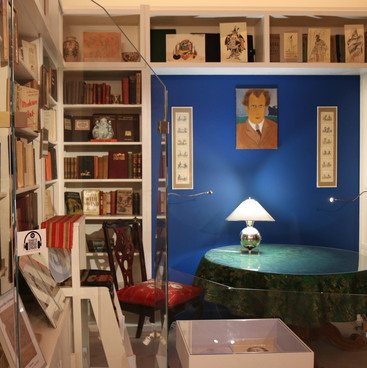Sergei Eisenstein was granted an apartment in the block built for MosfIlm employees on PotYlikha Street in 1935. The director lived there until his death on February 11, 1948. Eisenstein’s widow, Pera Atasheva (1900–1965), cinematographist and translator, has moved the belongings and archives of her late husband to her parents' apartment on Gogolevsky Boulevard; in 1962, she moved them again to a new apartment on Smolenskaya St. The house on Potylikha was already demolished at the time.
Every person who had the opportunity to become a guest of Sergei Eisenstein in his old apartment recalls a unique atmosphere that was present there. It looked nothing like the typical living space of a famous Soviet cultural figure in the 1930s and 1940s. The rooms were bright, the furniture was light and unique, shelves were full of books written in different languages. It was like a home of a collector of curiosities, or an artist’s workshop, or a home of a philosopher and pedagogue.
Owner of the apartment sometimes added new items to his collection. More shelves appeared to accommodate the expanding library. Only the nature of the decorations remained constant: light racks were set up all around the study and the library, light-grey — almost white — linoleum contrasted with the bright walls. Linoleum itself was a rare sight in Moscow at the time. Hand-knitted floormats were present throughout the interior.
The study itself was teeming with bright colors. It always felt like a sunny day inside this study, no matter the actual weather outside. The director has crafted the electrolier himself from the 18th-century ‘lomonOsovskoye’ glass and a metal base from a 14th-century chandelier.
The desk, the music stand, the chair, and all the other furniture were standing on bent steel legs with black or orange inserts — a design element common for the mid-1920s and early 1930s. All of this was created by the master craftsmen of the ‘Bauhaus’ international association, founded in Germany in 1919. Next to them is a late-19th-century chair, reupholstered with red brocade left over from the ‘IvAn GrOzny’ costumes on Eisenstein’s order. On Eisenstein’s desk, a mark from the famous branded department store in Prague is preserved. That store belonged to Joseph Roth.
All elements of Eisenstein’s study were in one way or another tied to his search cinema’s identity, which was the primary subject of his theoretical research. The right wall is dedicated to the Pathos and ‘depth of the shot’: Giovanni Piranesi’s prints with his architectural fantasies and reproduction of “Melodrama” by Honore Daumier with the scene at the boulevard theatre are displayed on that wall.
The left wall is dedicated to all matters comic: a reproduction of Daumier’s ‘Crispen and Scapin’ is right next to the portraits of Charlie Chaplin and Harpo Marx with gifting inscriptions, and a signed portrait of the songstress of the Mistenguet music hall in Paris. Makeup images from the Beijing Opera and a print with the characters of the Japanese Utsushi-e, or ‘magic lantern’ — a predecessor of the modern animation — are also found here. Colorful luboks are decorating the front wall; next to them, painted folk toys occupy the shelves.
Book shelves were recreated by researchers in accordance with the existing photographs. On these shelves, the works of Eisenstein (four books published during his life and many more modern publications) are displayed. Select works have been published in a number of foreign languages.
Every person who had the opportunity to become a guest of Sergei Eisenstein in his old apartment recalls a unique atmosphere that was present there. It looked nothing like the typical living space of a famous Soviet cultural figure in the 1930s and 1940s. The rooms were bright, the furniture was light and unique, shelves were full of books written in different languages. It was like a home of a collector of curiosities, or an artist’s workshop, or a home of a philosopher and pedagogue.
Owner of the apartment sometimes added new items to his collection. More shelves appeared to accommodate the expanding library. Only the nature of the decorations remained constant: light racks were set up all around the study and the library, light-grey — almost white — linoleum contrasted with the bright walls. Linoleum itself was a rare sight in Moscow at the time. Hand-knitted floormats were present throughout the interior.
The study itself was teeming with bright colors. It always felt like a sunny day inside this study, no matter the actual weather outside. The director has crafted the electrolier himself from the 18th-century ‘lomonOsovskoye’ glass and a metal base from a 14th-century chandelier.
The desk, the music stand, the chair, and all the other furniture were standing on bent steel legs with black or orange inserts — a design element common for the mid-1920s and early 1930s. All of this was created by the master craftsmen of the ‘Bauhaus’ international association, founded in Germany in 1919. Next to them is a late-19th-century chair, reupholstered with red brocade left over from the ‘IvAn GrOzny’ costumes on Eisenstein’s order. On Eisenstein’s desk, a mark from the famous branded department store in Prague is preserved. That store belonged to Joseph Roth.
All elements of Eisenstein’s study were in one way or another tied to his search cinema’s identity, which was the primary subject of his theoretical research. The right wall is dedicated to the Pathos and ‘depth of the shot’: Giovanni Piranesi’s prints with his architectural fantasies and reproduction of “Melodrama” by Honore Daumier with the scene at the boulevard theatre are displayed on that wall.
The left wall is dedicated to all matters comic: a reproduction of Daumier’s ‘Crispen and Scapin’ is right next to the portraits of Charlie Chaplin and Harpo Marx with gifting inscriptions, and a signed portrait of the songstress of the Mistenguet music hall in Paris. Makeup images from the Beijing Opera and a print with the characters of the Japanese Utsushi-e, or ‘magic lantern’ — a predecessor of the modern animation — are also found here. Colorful luboks are decorating the front wall; next to them, painted folk toys occupy the shelves.
Book shelves were recreated by researchers in accordance with the existing photographs. On these shelves, the works of Eisenstein (four books published during his life and many more modern publications) are displayed. Select works have been published in a number of foreign languages.

